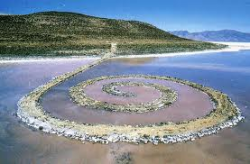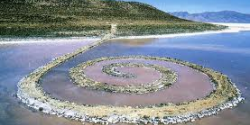 Earth was the artist’s first canvas. Before paint supplies and art tools, individuals used natural settings as means to document history and express cultural identity.
Earth was the artist’s first canvas. Before paint supplies and art tools, individuals used natural settings as means to document history and express cultural identity.
After tools to create paintings, sculptures, and sketches came into use, some artists – like the late Robert Smithson – still chose to create massive artistic marvels using natural elements. Earthwork, as it is commonly known, consists of large scale artwork that is set in nature and composed of the elements.
The Spiral Jetty, located at Rozel Point in Great Salt Lake, Utah is the defining earthwork of Smithson. In 1970, he used “mud, precipitated salt crystals, and rocks” to create a 1,500 foot long, 15 foot wide water coil.
Any challenges the artist was confronted with when creating the Spiral Jetty may be comparable to the work that is going into conserving the art. As nature continues to recreate this work of art, the importance of documenting this earthwork is ever more important.
How Is The Spiral Jetty Being Preserved?
Both nature and man have made quite the impact on the Spiral Jetty. In recent years, because of drought, the earthwork has emerged from its safe home underwater. Smithson was said to have been, “fascinated by the concept of entropy…” and may have even “…welcomed this transformation.” However, less appealing are the man made changes that occur when visitors, who have access to the site, walk away with rock souvenirs.
Today, the Dia Center for the Arts, which acquired the Spiral Jetty from the Robert Smithson Estate in 1999, is partnering up with the Getty Conservation Institute to document the earthwork regularly. Only time will tell if there will need to be conservation efforts to keep the Spiral Jetty constructed in the way Smithson intended it.
The preservation efforts are inexpensive and consist of a disposable latex weather balloon, which monitors the vast creation from above. The images, captured with a Canon point and shoot camera, help conservationists see how the work of art is changing over the years. These photographs will be useful in continuing to weigh options as to how they may best preserve, and possibly restore the piece.
Why Is It Important To Preserve Earthwork?
As nature and people threaten the structure, there may come a day when portions of Smithson’s Spiral Jetty needs to be rebuilt. Though many of the existing earthworks were created to withstand the elements, they may need to be touched up and monitored to ensure they last for years to come.
For the sake of preservation, it is important to be mindful of how both art and nature impacts the world around us. One reason why earthwork captivates us is because these pieces are subject to the elements. This means they are always changing and reshaping, to create a unique type of art. When merging man’s abilities with the natural world, it is important to maintain man’s hard work and nature’s creativity.
References:
http://www.nytimes.com/2009/11/18/arts/design/18spiral.html?_r=1&
http://www.robertsmithson.com/earthworks/spiral_jetty.htm
http://www.getty.edu/conservation/publications_resources/videos/focus/spiral_jetty.html
Read more Segmation blog posts about art beyond the canvas:
Be an Artist in 2 minutes with Segmation SegPlay® PC (see more details here)
Join us on FacebookSegPlay® Mobile iTunes now available for iPhone and iPad







I love the term, “Earthwork.”
Thank you. I love the term “Earthwork” as well. http://www.segmation.wordpress.com
i wonder if earthworks could become examples of earthwork?
Maybe. http://www.segmation.com
Gotcha.
to what degree does the inner landscape of the human form inform our experience of this outer landscape?
So much here I never considered. Thank you so much for writing this post.
Glad you enjoyed my post! http://www.segmation.wordpress.com
Reblogged this on Sea-girt Ithaca and commented:
Readers of this blog are more likely to encounter “earthworks”: here is what happens with the singular of that term.